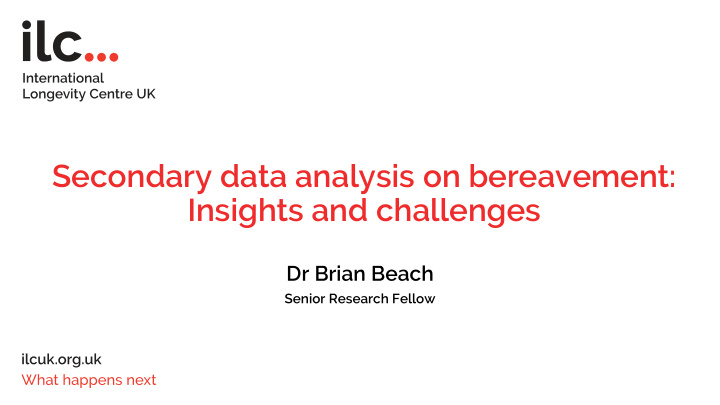



Secondary data analysis on bereavement: Insights and challenges Dr Brian Beach Senior Research Fellow
Key points for today • Exploring bereavement in secondary data • Key findings from ELSA • Implications for policy
Bereavement and secondary data • Rich survey data exist in the UK, covering a wide range of topics • Few focus on the experience of bereavement VOICES – unpaid carers’ views on quality of care • • Greater challenges in understanding the impact of bereavement over time
Research on bereavement • Good grief – 2018 report from Independent Age • ILC provided quantitative analysis using the English Longitudinal Study of Ageing (ELSA) • Focus on partner loss between waves Limitations due to interval censoring •
Key findings from ELSA • Only a small proportion of people aged 50+ lost their partners between waves: 1.7% in 2014/15 to 2.9% in 2010/11 Differences may relate to refreshing the sample • Overall, 9.7% across the period 2002-2015 • • Of those bereaved, 47% were aged 65-79; but nearly a quarter of those 80+ were bereaved • The bereaved reported worse outcomes across a range of health- and wellbeing-related indicators – especially depression
Key findings from ELSA Not Bereaved Bereaved N Not lonely (3-4) 74.1% 36.1% Moderately lonely (5-6) 20.9% 34.2% 7706 Highly lonely (7-9) 5.0% 29.7% Not isolated (0) 40.0% 45.7% Moderately isolated (1-2) 54.0% 50.4% 6964 Highly isolated (3-4) 6.0% 3.8%
Implications for policy • Need for robust, representative data over time • Specific challenges for underrepresented groups (e.g. BAME, migrants, LGBT+) • Bereavement in later life may take a different shape than bereavement earlier in the life course – will consequent impacts on people’s ability to cope and the kinds of support needed.
Thank you Dr Brian Beach Senior Research Fellow BrianBeach@ilcuk.org.uk @ilcuk
Recommend
More recommend